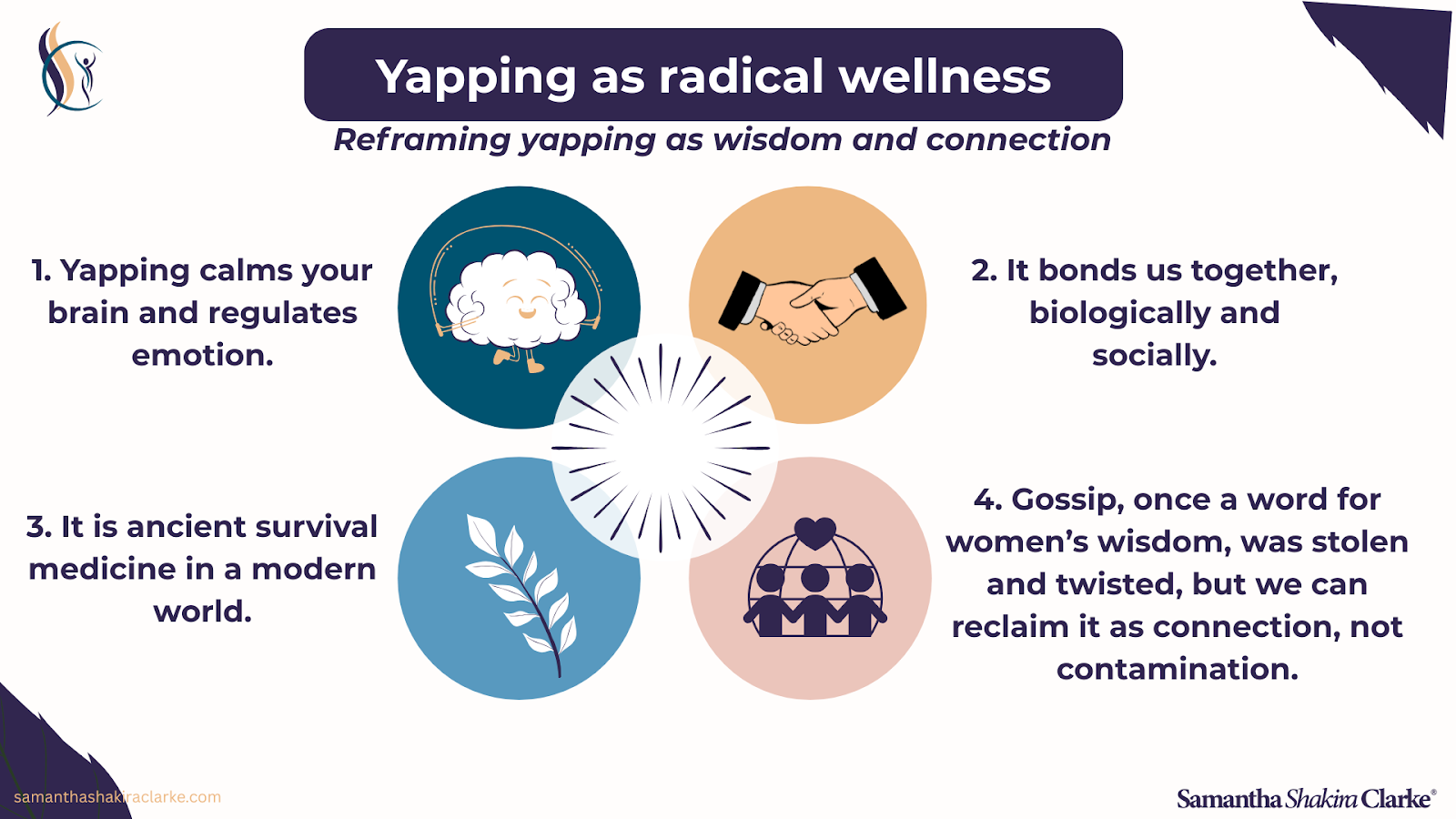 Book Now!
Book Now!Humans have been accused of “yapping” since the beginning of time. It’s the word we use when someone is going on and on, maybe oversharing, maybe telling us the life story of their cat when we just asked how their weekend was. But what if yapping, talking, venting, storytelling, word-vomiting, wasn’t just noise? What if it was medicine? What if it was part of the science of connection and the benefits of talking out loud?
For years, I took offense when someone called me a yapper. It felt like “less than,” as if my words weren’t serious, my thoughts weren’t intelligent, my voice didn’t matter. Over time, the word began to shift. In my own circles, “yapping” became a loving shorthand for connection, an accepted way of saying, “we talked, we bonded, we’re alive together.” That is what pulled me into the history of the word, and the science behind its surprising validity.
The word “yap” first appeared in the 1600s, mimicking the sharp bark of a little dog. By the late 1800s, it stretched to humans, meaning idle chatter, shrill talk, something irritating and trivial. It carried stigma, especially for women, as if too many words spilling out of a feminine mouth were a flaw. Yet modern science shows that “yapping” is one of the most important tools we have for health, wellness, and human connection.
When you talk about your experiences, your brain lights up in multiple regions at once. The prefrontal cortex, which is responsible for reflection and problem-solving, joins forces with the limbic system, which processes emotions, to weave meaning. This is why you often do not know exactly how you feel until you start saying it aloud.
Scientists call this affect labeling, a process in neuroscience that shows how emotional regulation through speech calms the brain. Research demonstrates that it lowers activity in the amygdala, the brain’s alarm bell, and boosts regulation in the brain’s control centers. In simple terms, naming your feelings out loud calms your nervous system. Yapping is self-soothing, but with extra flair.
Humans didn’t evolve to sit in silence. We evolved to chatter. Anthropologist Robin Dunbar argues that gossip may have taken the place of grooming in early societies. Picking bugs out of each other’s hair kept primates bonded, but language let us bond faster, in bigger groups. Yapping was survival.
When someone genuinely listens to you, your body rewards you with oxytocin, the hormone of trust and bonding. That is the same hormone that spikes when hugging, breastfeeding, or falling in love. The role of oxytocin in bonding is so powerful that being heard is a chemical hug. And of course, yapping works best when it is met with listening. Connection is always a two-way street.
911 calls: People who continue talking, describing their situation, even repeating themselves, often help themselves survive crises. Keeping callers engaged and verbally anchored can be life-saving in emergencies, as research on behavioral health crises shows (Pew Research).
Prison storytelling circles: Programs that give inmates space to narrate and reflect on their stories, like restorative justice circles, reduce reoffending and foster identity transformation. Sharing stories reshapes lives (SAGE Journals, Greater Good Science Center, UNODC).
Doctor’s visits: Narrative medicine, where patients share more than just symptoms, consistently shows improved mental and physical outcomes. It deepens empathy, patient satisfaction, and healing by activating the parasympathetic nervous system’s repair mode (PMC, Springfield Clinic, The Guardian).
If yapping has been dismissed as trivial, gossip has been branded as dangerous. Yet the word “gossip” comes from godsibb, an Old English word meaning god-sibling or trusted companion. In medieval times, “gossips” were the women who supported each other at births, intimate and knowledgeable allies.
Over centuries, that meaning twisted. As patriarchal systems gained ground, women’s communal talk was recast as idle, shameful, even subversive. Gossip became a way to trivialize or silence women, discouraging them from sharing truths about their communities. By the 16th century, the word had mutated into “idle chatter,” a tool of social control meant to shame women out of conversing.
But gossip has always been more than whispers. It has been a way to share knowledge, keep communities safe, hold power accountable, and bind people together. The history of gossip shows that it was once women and storytelling at the heart of community truth. Today, research shows that gossip, when used with intention, can strengthen social bonds, build trust, and even surface hidden problems in organizations.

The next time someone teases you for rambling, remember that your yap might be rewiring your brain, lowering your stress hormones, and strengthening your relationships.
Yapping is not noise. It is communication and mental health in action. It is connection, healing, and in many ways, what makes us human.
So go ahead, send that sprawling voice note, tell that meandering story, let your words spill. Let’s stop apologizing for our yaps and start celebrating them. Call it yapping, call it storytelling, call it medicine. Just don’t bottle it up.
And if someone calls you a yapper, take it as the highest compliment. You are practicing ancient medicine with every word.



